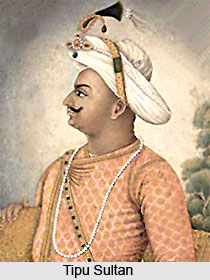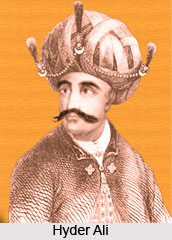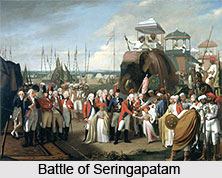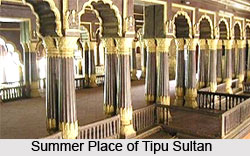 The military administration of Tipu Sultan consisted of naval and army forces which were well developed by the Sultan considering almost all parts of militancy.
The military administration of Tipu Sultan consisted of naval and army forces which were well developed by the Sultan considering almost all parts of militancy.
To fight with the British forces Hyder Ali decided to form a powerful naval force and the same need was felt by Tipu Sultan and he took proper steps to reform the naval and army forces of Mysore and to curb the success of the East India Company. In doing so their strategy was to seek the help of the European rivals of the British namely the French, the Dutch and the Portuguese. They also succeeded in attracting some British subjects who helped them to build and also command some of their ships.
During the reigning period of Hyder Ali, a naval fleet was created some including good ports and ship building yards. Tipu possessed a number of men of war and had about 10,000 men staffing a variety of ships. He issued marine regulation in 1796 and ordered the immediate building of forty warships. Contemporary British records state clearly that Hyder Ali and later Tipu Sultan were most formidable enemies of the British. They maintained a steadfast alliance with the French against their common adversary. Evidence also exists of their efforts to maintain good rela¬tions with the Portuguese. The Mysore rulers had also tried to enter into alliances with Afghanistan, Muscat, and Turkey, which necessi¬tated the building of a strong navy. Moreover their English enemies were strong on the sea, their Portuguese neighbours relied on their navy in their struggle with Indian states, and the Peshwa possessed a fleet of his own. And the conquest of the Malabar Coast put Hyder Ali and Tipu in possession of the famous ports and the ship-building yards of that region.
Earlier, Hyder Ali built watercrafts in the East India Company"s marine yards at Honavar in 1763. He is reported to have had a large fleet which the East India Company claimed to have destroyed in the year 1768. The Portuguese evidence proves that by 1765 the Mysore navy possessed 30 vessels of war and a large number of transport ships which were commanded by an Englishman with some European officers. The Portuguese records further explain how Hyder Ali planned to build the most powerful fleet in Asia by building a stockade above the waterline in the Gulf of Batical in 1778. Unfortunately, in 1780 Admiral Edward Hughes dealt a fatal blow to this maritime power.
It has been known that Tipu"s navy had practical existence as early as 1787. After the defeat of 1792, the Mysore sovereign turned his thoughts seriously to building a navy. A separate Board of Admiralty was established in September 1786 and express orders were issued for the building of 40 warships and a number of transport ships at the Jamalabad, Wajidabad and Majidabad dockyards and other places on the west coast.
In the establishment of British rule in South Asia naval supremacy, no doubt, played a vital role. Those who resisted British aggression either did not fully appreciate the value of naval power or lack¬ed the determination and resources to build up a navy which could offer effective resistance to the British naval might. Of the indigenous rulers, Tipu Sultan was one of the few who recognized the importance of naval power. In 1768 the desertion of his naval commander, Stannet, caused the loss of many ships. Tipu Sultan, on succeeding his father, first turned his atten¬tion to the building up of his army; but even so, he possessed from the beginning a number of war vessels. The chief function of these ships was to protect merchant ships from piracy. Administratively they were placed under the Malik-al-Tujar or the Board of Trade. The Third Mysore War convinced Tipu Sultan of the necessity of a strong navy, and during the last few years of his life he showed great keenness in this connection. By 1794 the Sultan had decided upon the construction of 40 warships.
 In 1796 Tipu Sultan issued a "hukmnamah" or ordinance which laid down the regulations for the naval building programme which he had undertaken. It is addressed to the "mirs yam" or lords of the Admiralty who were eleven in number. These "mirs" constituted the Board of Admiralty with their headquarters at Seringapatam. The Board was established in the Jafari month of the Mauludi year 1224, reckoned from the birth of the Holy Prophet, corresponding to September 1796. Next in rank to the "mirs yam" were the "mirs bahr" who were officers of the highest rank to serve on the seas. Two of these were assigned to each squadron of four ships; in modern terminology they may be termed admirals or commodores.
In 1796 Tipu Sultan issued a "hukmnamah" or ordinance which laid down the regulations for the naval building programme which he had undertaken. It is addressed to the "mirs yam" or lords of the Admiralty who were eleven in number. These "mirs" constituted the Board of Admiralty with their headquarters at Seringapatam. The Board was established in the Jafari month of the Mauludi year 1224, reckoned from the birth of the Holy Prophet, corresponding to September 1796. Next in rank to the "mirs yam" were the "mirs bahr" who were officers of the highest rank to serve on the seas. Two of these were assigned to each squadron of four ships; in modern terminology they may be termed admirals or commodores.
The programme contained in the "hukmnamah" visualized a naval force of forty ships which was to be placed under the care and superintendence of the "mirs yam" as soon as they were ready. They were, moreover, to be built with all possible dispatch. The names given to them all ended with the word "Bakhsh", e.g., Muhammad Bakhsh, Ali Bakhsh, Sultan Bakhsh, etc. signifying "bestowed by" or gift of Muhammad, Ali and the Sultan respectively.
The ships were divided into three "kachehris" or divisions, namely, the "kachehri" of Jamalabad or Mangalore, the "kachehri" of Wajidabad or Bascoraje and the "kachehri" of Majidabad or Sadasheogarh. The first of these "kachehris" was to consist of 12 ships and the last two of 14 ships each. With a view to expediting the completion of the project two "mirs yam" assisted by a mirza-i-dajtar (office superinten¬dent) and a mutasaddi (accountant) were appointed at Mangalore from whence they were to superintend the construction of the vessels intended for the Jamalabad division. Two other "mirs yam", together with a mirza-i-daftar and a mutasaddi each, were stationed at or near Mir Jan Creek for the purpose of directing the construction of vessels for the Wajidabad and Majidabad divisions.
The Admiralty Board was supplied with a model ship with a tiger figure head according to which all the watercrafts were to be built. The timber for the ships was to be procured from the state forests and then floated down various rivers to the respective dockyards. The number of officers for the fleet fixed in the "hukmnamah" was as follows: there were to be in all 11 "mirs yam", all stationed at the capital and 30 "mirs bahr", of whom twenty were stationed on ships, two assigned to each squadron; and ten were to remain at the capital for instruction. The salary of the "mirs yam" and such "mirs bahr" as attended the court was to be fixed according to their qualifications. The twenty "mirs bahr" serving on the ships were to receive a monthly salary of 150 imamis or rupees.
The land establishment of each "kachehri" was to consist of three office superintendents, three writers, twelve clerks (gumashtas), one judge (qazi), two proclaimers, (naqib), eleven attendants (hazirbashi), eleven literate scouts (sharbasharari), and one chamber¬lain (farrash) who had charge of camp equipment and carpets, one torch-bearer or link-boy (mashalchi) and one camel-driver (sarban).
Each ship of the line included some officers like four "sardars" (officers) denominated first, second, third and fourth, two "tipdars" and six "yuzdars", along with a number of sub¬ordinate officers. The first "Sardar" was to have overall command. The second "Sardar", with one "tipdar" and two "yuzdars" under him, was placed in charge of the guns and gunners, the powder magazine and every¬thing else appertaining to the guns as well as of the provisions. The third "sardar", with one "tipdar" and two "yuzdars" under him, was in charge of the marines and small arms. He was also to look after spare tools, implements and stores. The fourth "Sardar" was to have particular charge of the "khalasis" or sailors, and of the artificers belonging to the ship such as blacksmiths, carpenters, etc. He was expected to superin¬tend the cooking of the food and its distribution among the crew. The navigation of the ship was also entrusted to him. He was to look after the tools and implements in immediate use which had to be kept in a proper condition. Any damage caused to the ship during war was to receive his immediate attention. All the above officers were to be carefully selected and only persons of good parentage and some amount of education were to be employed.
 The complement of each line-of-battle ship was fixed at 346 men. Thus all the twenty line-of-battle ships together were to have an establishment of 6,920. The establishment was divided into five main categories: the musketeers, the gunners, the seamen, the artificers and the officers. Each category was divided into several sub-categories. Among the musketeers were included "tipdars", "sharbasharans", "nafir-nawazes" (fifers), "shahnainawazes" (trumpeters), "yuzdars" (lieutenants), "sarkhils" (second lieutenants), "jamadars" (sergeants), and privates. The gunners similarly were categorized as "tipdars", "yuzdars", "sarkhils", "jamadars" and privates. The seamen included "jaqdars", "dafadars" and privates. The artificers consisted of smiths and carpenters with a head-smith and head-carpenter. Officers included not only the first, second, third and fourth "Sardars" but also the pilots, "darughas", physi¬cians and superintendents of offices. Details were given in the "hukmnamah" of the compensations to be paid to the different classes of men. Apart from the regular salary there was also the institution of a subsistence allowance.
The complement of each line-of-battle ship was fixed at 346 men. Thus all the twenty line-of-battle ships together were to have an establishment of 6,920. The establishment was divided into five main categories: the musketeers, the gunners, the seamen, the artificers and the officers. Each category was divided into several sub-categories. Among the musketeers were included "tipdars", "sharbasharans", "nafir-nawazes" (fifers), "shahnainawazes" (trumpeters), "yuzdars" (lieutenants), "sarkhils" (second lieutenants), "jamadars" (sergeants), and privates. The gunners similarly were categorized as "tipdars", "yuzdars", "sarkhils", "jamadars" and privates. The seamen included "jaqdars", "dafadars" and privates. The artificers consisted of smiths and carpenters with a head-smith and head-carpenter. Officers included not only the first, second, third and fourth "Sardars" but also the pilots, "darughas", physi¬cians and superintendents of offices. Details were given in the "hukmnamah" of the compensations to be paid to the different classes of men. Apart from the regular salary there was also the institution of a subsistence allowance.
Twelve small ships were on the occasion delivered to the "mirs yam". Of these ten were cargo-boats, five of them at Mangalore and five at Onore. The other two were called Asadullahis. All these smaller vessels were to be used for training the naval crew for the ships which were being built. With the same object it was directed that a kind of buoy should be anchored in some suitable place and a flag erected thereon, to serve as a mark for practicing with cannon. Instruction was to be imparted to the gunners with the greatest care.
The "hukmnamah" insisted that the timber used in the cons¬truction of ships should be seasoned and for this purpose the wood, after being felled and barked should be kept lying from one to two years. Only when, judged by the highest standards, it was perfectly seasoned, was it to be used. The men recruited for service with the navy were to be sworn in at Seringapatam in the presence of Tipu Sultan himself, and then sent to their respective destinations. The movements and warlike operations of ships were similarly placed under the directions of the "mirsyam" and "Asifs". Four "kothis" or business houses, called "factories" in those times, two at Muscat and two at Kutch, which had already been in existence when the "hukmnamah" was issued, were placed under the "mirs yam" for the purpose of protection. At each of these factories two "yazaks" (platoons of 12 men) of the regular troops were to be stationed. It may well be that the naval building programme of Tipu Sultan was one of the important reasons why the British precipitated a war with him so that his plan might be nipped in the bud.
The formation of army of Tipu is also a notable feature of his military administration. The army of Tipu Sultan specified that advantage should be taken, wherever possible, of rivers, shrubs, rice-fields, streams, hills, and thickets, which should be kept on one side and, after leaving an open space in the centre, soldiers should be encamped on the other side. In between the soldiers and the central court should be located the camp followers, goods and chattel. The tents were to be pitched in such a manner as to avoid the wind so that the army might not be troubled with wind and dust. After these general remarks the tables that follow give seven patterns of encampment. The first table contains a rectang¬ular plan of encampment with an entrance in front only. Guns are located at all four corners and at the entrance. Two tents in front and one on each of the three sides seem to be meant for officers. The central position is occupied by the "bargah-i-mualla", elsewhere mentioned as "bargah-i-khass" or Tipu Sultan" own tent which is surrounded on three sides by two rows of tents, one of the inner guard and the other of the outer guard. In front of the "bargah-i-mualla" is the secretarial office and a little further are two rows of tents for the ad¬vance guard at the foot of which are the stables.
Still further and exactly opposite the "bargah-i-mualla" is the "naqqar-khanah" or the place where the drums were beaten at stated intervals, and there are two rows of shops. To the right of the "naqqar-khanah" is the place for the chief standard. Finally all these are surrounded by the tents of the soldiery. The second table has a river bend as the base on one side and the soldiers" tents are pitched in a single row forming the diameter for the semi-circular bend.
 The third table has many features in common with the first table, with the difference that there are four entrances instead of one, and guns are placed close to one another and not only on corners. Stables for camels and elephants are located at the back of the "bargah-i-mualla". In the fourth table the "bargah-i-mualla" is protected by only one row of guards which is located at a distance of forty yards The tents of the soldiery are in four groups, two in front and two at the back of the "bargah-i-mualla", the two sides on the right and left of it are not utilized for the purpose. The fifth table follows the pattern of the fourth except that the tents both in front and at the back are arranged in perpendicular rows and not horizontally. The sixth table visualizes encampment by the side of a river and the camp is arranged parallel to it, there being a single row of tents in front and another at the back of the "bargah-i-mualla". The main feature of the seventh and the last table is that the tents are arranged mainly in two rows on the right and left of the "bargah-i-khass".
The third table has many features in common with the first table, with the difference that there are four entrances instead of one, and guns are placed close to one another and not only on corners. Stables for camels and elephants are located at the back of the "bargah-i-mualla". In the fourth table the "bargah-i-mualla" is protected by only one row of guards which is located at a distance of forty yards The tents of the soldiery are in four groups, two in front and two at the back of the "bargah-i-mualla", the two sides on the right and left of it are not utilized for the purpose. The fifth table follows the pattern of the fourth except that the tents both in front and at the back are arranged in perpendicular rows and not horizontally. The sixth table visualizes encampment by the side of a river and the camp is arranged parallel to it, there being a single row of tents in front and another at the back of the "bargah-i-mualla". The main feature of the seventh and the last table is that the tents are arranged mainly in two rows on the right and left of the "bargah-i-khass".
The seven tables together throw interesting light on an important aspect of the organization of Tipu Sultan"s army. The constructive arrangements of Tipu Sultan"s military administration testify about the keen precautious mentality and intense knowledge about the both side of combativeness. The details available in the "Hukmnamas" evidences that no doubt that the Mysore navy would have been the most powerful fleet in Asia and would have compared favourably with the best fleet in existence anywhere in the world, but the sudden death of Tipu in 1799 brought a bolt from blue and the formation of navy was stopped in midway.






































